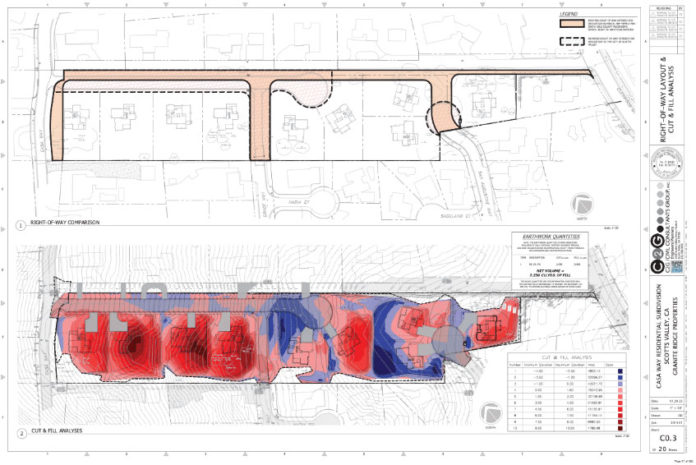There was some grumbling from neighbors about potholes in the vicinity, and disappointment a pedestrian cut-through will disappear, but the Scotts Valley residents at the final hearing about the subdivision seemed relatively pleased overall with it.
The nine-unit Casa Way classic suburban development from East Palo Alto’s Granite Ridge Properties (Sandraya Heights LLC) was approved 4-0 at the regularly-scheduled Jan. 17 Scotts Valley City Council meeting, with Councilmember Derek Timm absent.
“I think this benefits the neighborhood,” said Mayor Randy Johnson in an interview about the plan for the Sandraya Heights Road and Casa Way area. “What you’re going to see, I think, is cooperation with the developer and the existing neighbors.”
Though no pro-housing “yes in my backyard” activists appeared to fight against the project, whether or not to push for higher density was something the elected officials did ponder when deciding what to do with the valuable virgin land within striking distance of Silicon Valley.
Allan Timms, the newest member of the Council, was the first to broach the subject, wondering if the City should push the developer to include more places for people to live.
“We have a lot of homes to be built,” he said, referring to the 1,220 units—plus a buffer beyond that—Scotts Valley is required by the State to plan for over the next several years. “It’s an important question to be asked.”
Even the mayor, generally more of a traditionalist, wasn’t about to reject this concern outright.
“I think on balance, it’s such an interesting question,” he said. “Thirty years ago, no one would be talking about higher density—in any shape or form.”
But Johnson also knew that what was before them was exactly the sort of low-density development a lot of constituents would prefer to see.
“Chances are these are going to be very attractive homes that will probably benefit the neighborhood,” he said.
But he did try to push the developer to offer more to neighbors for improvements.
“We have a lot of people here, but only a few spoke,” he said, suggesting this is proof the community is largely happy with the proposal, and are simply seeking some street resurfacing and other minor repairs.
The developer declined to put in any more money, but agreed to work with the neighbors to help them negotiate a lower price for road renovations.
Site analyses found “potentially significant impacts to biological resources,” such as the Scotts Valley spineflower, roosting bats, dusky-footed woodrats and Scotts Valley polygonum, though staff said the developer had agreed to a mitigation plan for multiple species.
“The federally endangered Scotts Valley spineflower (Chorizanthe robusta var. hartwegii) occurs on the project site where it was first observed by members of the Service and local biologists in 2018,” California Department of Fish and Wildlife Field Supervisor Stephen P. Henry wrote to Scotts Valley Aug. 16. “While the Sandraya population is small in number and areal extent, its loss may nonetheless represent a significant impact to the survival and recovery of species as a whole due to its limited distribution and numbers, specialized habitat, and vulnerability to threats.”
Henry suggested the Salvation Army Redwood Glen Camp, Scotts Valley High School Preserve or the Glenwood Open Space Preserve could be good options for off-site plantings of the spineflower and polygonum.
Not everyone was thrilled about the development.
“As far as there being more houses, I would say, ‘No, no, no, please no,’” Daryl von Haunalter said during public comment.
However, most citizens expressing dissatisfaction with elements of the project also seemed aware they might hate what could come along next more if this one was rejected.
The fact that the new SB9 law will likely allow the lots to be split into multiple parcels in the future was enough to convince Timms that some housing was better than none at this point—and to not require a more ambitious proposal from the developer when it comes to unit count.
Granite Ridge Properties Managing Director Melissa Leet said the company sought to maintain good relations with their new neighbors throughout the approval process.
“We feel quite proud that we’ve been able to come into the community and find a solution that by-and-large satisfies as many people as possible,” she said.
“At least they didn’t do more than nine,” said von Haunalter, upon exiting Council Chambers.














